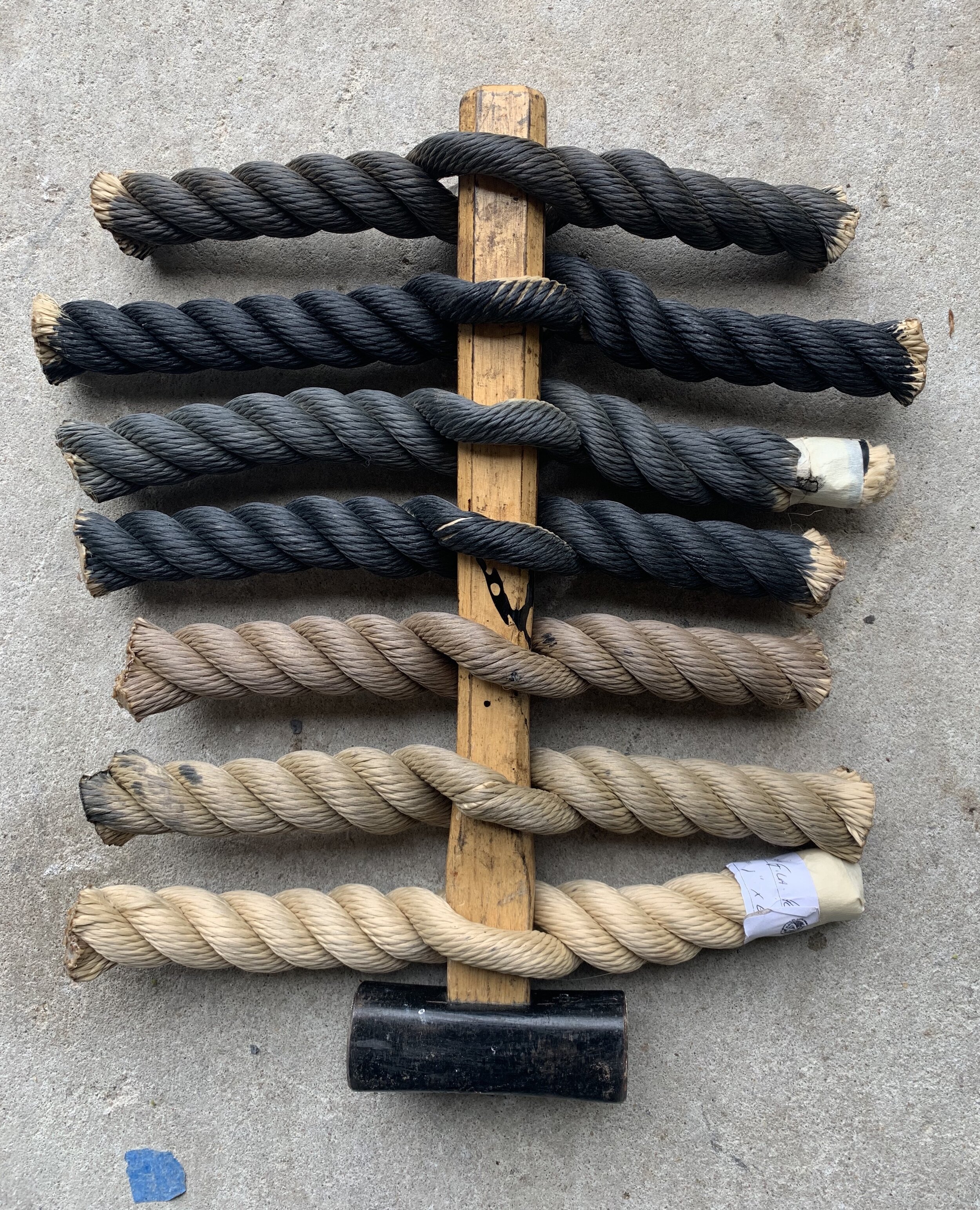Stay-at-Home Rigger
/The Maryland dove will be outfitted with an entirely synthetic rig of traditional construction. This means that the materials will be of polypropylene, polyester, or dyneema, while the construction or structure of the product will be traditional, that is, right hand laid three strand rope also known as right laid hawser rope.
In the early 17th century the Dove would have been built with a rig of hemp. The running rigging which is manipulated by hand , capstan, or windlass and used in conjunction with blocks in order to gain mechanical advantage for easier manipulation of sails and spars, is frequently worked and worn and would most often be left raw without the addition of any preservative treatment. The standing rigging which is primarily static and transfers force away from the mast to the hull would be treated with pine tar, a common antimicrobial, anti-fungal, sticky preservative which helps prevent against the natural material decaying as a result of fungal rot.
The dark burnt earth color that one associates with pine tar and remains at the forefront of the sensuous experience of traditional rigging has been attempted to be replicated in the treatment, albeit relatively unnecessary treatment, of traditional modern or synthetic rope products. A quick history of our insistence on using pine tar in traditional rigging:
1850- iron wire rope begins to be used in standing rigging, this rope is prone to corrosion, the lay of the wire is filled with strands of hemp marline, this process is called worming. The wire is then wrapped in canvas which is tarred, this process is called parceling. Finally, a tightly wound layer of tarred hemp marline is applied which is called serving. The tar prevents the canvas and hemp from rotting and provides a water barrier to the sensitive wire, in this application the preservative qualities of pine tar are applicable and appropriate. This procedure of serving was adapted to iron wire from its long use with hemp rope and is also later used with galvanized steel wire.
1990s- synthetic nylon twine saturated in net dip and sold as “tarred seintwine” is used in the serving of galvanized wire rope on tall ships especially in North America. The seintwine then receives subsequent coatings of pine tar occasionally mixed with black oil enamel or varnish to aid in the drying of the tar, the insistence on using pine tar seems to be a result of inheritance from a generation familiar with hemp marline, which by this age has become increasingly uncommon.
I might still advocate the usage of pinetar with a drying agent on synthetic marline over wire as it continues to provide a water repellent barrier and a traditional appearance, that being said, applying pine tar to synthetic rope in the manner of hemp rope is ineffective as it will never achieve proper saturation or adhesion. When pine tar is applied to a length of new rigging in the rig shop with synthetic marline or seintwine and that piece is then coiled up and hung, you will find that the slow drying pinetar will travel down along the wire over the course of a week to saturate the lower part of the coil, even dripping out from the service slowly onto the rig loft floor. This would not happen with hemp marline as it is far more absorbent in its basic fibers (the first principal component of rope- fiber/ yarn/ strand/ rope/ *cable) more so then soft spun polyester and certainly more so than polypropylene. For this reason, I have begun to experiment with synthetic rope preservatives and coverings with the aim at replicating not only the appearance of tarred hemp, but also an added UV and abrasion resistant coating to our synthetic material.
The Dove will be using 5 or 6 types of rope. The 5 principle types in order of strength will be:
Hempex (UV resistant spun or soft polypropylene)
Polytex (abrasion and UV resistant polypropylene)
POSH (prestretched spun polyester)
Polyester Classic (prestretched, heat treated polyester)
Mystic 3 Strand (polyester and Dyneema)
A 6th type which is served rope with synthetic marline or “seaman’s twine”.
In order to test the following products I will apply a single coating of each preservative to each type of rope including a length of served rope. Below you will see Polyester Classic as a primary example for it is the most stubborn in its material (less absorbent filament polyester). The products chosen from previous experience, manufacturer recommendation, and the advice of colleagues in the rigging industry are as follows:
From bottom to top:
1) untreated polyester classic rope from Langman Ropes
2) 2 part tar- 1 part varnish- a cap of japan dryer per quart
3) 3 part tar- 1 part gloss enamel oil paint
4) industrial black plastic net paint (acrylic)
5) 4 part industrial black plastic net paint- 1 part water
6) black acrylic paint
7) industrial netcoat (asphalt)
As expected both traditional tar mixtures are inefficient to treat a filament polyester such as what you see above used for standing rigging and pendants. This narrows that selection down to our acrylic net paint, standard acrylic paint, and asphalt net coat. The industrial plastic net dip has great coverage thinned or not and excellent saturation when thinned although it could probably use a second coat right off the bat (see ropes 4 and 5). The art grade black acrylic sits on top of the material similarly to the industrial plastic paint, but doesn’t seem to saturate the fibers. Lastly, the asphalt net coat, applies very consistently, saturates completely to the inner strand unlike any of the other paint options, and also not without importance, goes a long way in its application compared to the acrylic paint products. The asphalt also dries to a very slight tacky finish similar to pine tar, making it my number one initial choice.
Next I will lay lengths of treated material out in the sun for the summer and partially submerge a few lengths in the water to observe algae growth which will provide me with enough data to make a confident selection in choosing the preservative for the rig of the Maryland Dove.
Till next time
SH




